Insight and opinion
The Future of Digital Interfaces
I recently visited Birmingham Design Festival, which was a feast for the digital and graphical minds of the Midlands. One talk that stuck with me was from Johanna Drewe (Studio Output) on Future Interfaces. I couldn’t shake the questions that she provoked in me – how can we embrace the future of interfaces as both designers and consumers?
Put simply, an interface is the way in which we interact with technology to achieve a desired outcome. Historically, we have adopted many types of interface – mouse, keyboard, touch, voice, movement, gestures. Where typically we would be familiar connecting with technology via these interfaces, we are starting to see a reversal of this. We’re now seeing technology interacting directly with us to achieve our desired goals. This raises the question…
“Are we the new interface?”
– Johanna Drewe, Assistant Creative Director, Studio Output
Fitbit is already monitoring our heart rate to deliver us information on health and fitness. Apple is already using facial recognition to enable payments. There’s even a headset that can hear your internal voice! More and more advancements are showing us that the future interface is human.
This interface reversal is beginning to make everyday tasks even easier for us and this will only continue. Imagine a car that reads your body temperature, detects you are hot and automatically switches the air conditioning on. What if Netflix could read your body language and facial expressions to dynamically adjust their storylines to maintain your interest and keep you watching?
This shift in technology is enabling us to be more passive in achieving our desired goals – are these advancements helping us to be…less advanced? It’s slightly worrying to think what impact this could have on human behaviour and society as a whole.

But before we reach that point, there are a number of barriers that will hinder the adoption of emerging UIs:
Social space
Natural user interfaces (NUI) such as touch, gestures and voice, are not widely adopted in social spaces. People still don’t want to be seen moving in unnatural ways or speaking out personal information in public.
Unfamiliarity
Just like a door handle lets you know a piece of wood is a door, we’ll need to develop instincts about which objects or environments we can interact with and how.
Privacy
This is a biggy. Although VUIs are becoming more commonplace, not everyone feels comfortable knowing that Alexa is recording everything in anticipation of giving us the response we’re looking for. Alexa, stop listening.
Ethics
Remember Google Glass? This didn’t take off because of the negative implications of the wearer walking around capturing everyone’s behaviour without their permission.
Overcoming the barriers
We could create the most usable and innovative interfaces known to technology, but they will fail if our users choose not to adopt these alternative UIs into their everyday lives.
Firstly, as designers, we need to start designing interfaces that are natural, instantly recognisable and intuitive, that don’t break our ethical code and respect our privacy. Secondly, it will require a societal shift that makes these future interfaces familiar enough to become the social norm, helping us to be more natural in our digitally-evolving environments.
The future of interfaces are in the hands of forward thinking designers but rely on society’s acceptance and adoption if they are to succeed.